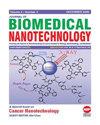原位荧光探针快速筛选肺癌患者胸水脱落细胞中表皮生长因子受体和KRAS突变的分析
IF 2.9
4区 医学
Q1 Medicine
引用次数: 0
摘要
为了提高胸膜积液中非小细胞肺癌(NSCLC)脱落细胞的检出率,我们设计了能有效结合肿瘤细胞中突变癌基因的纳米msn - dna荧光探针。通过共聚焦显微镜可以直接通过荧光强度检测突变的NSCLC细胞,而无需使用传统的聚合酶链反应(PCR)。此外,DNA探针在NSCLC细胞中具有高通透性,在低温甲醇中稳定。利用纳米msn - dna荧光探针,我们检测到表皮生长因子受体(EGFR)和KRAS突变在非小细胞肺癌胸膜积液和细胞中的发生率明显高于正常患者,尤其是肺腺癌细胞。EGFR和KRAS突变更容易发生在低分化和临床晚期NSCLC中,突变增强了肿瘤的侵袭性,导致预后不良。纳米msn - dna荧光探针对胸膜液脱落性肺鳞癌和腺癌细胞的筛查敏感性明显高于Wright染色。因此,纳米msn - dna荧光探针在筛选肺癌患者胸膜液脱落细胞和指导靶向治疗方面具有很大的潜力。本文章由计算机程序翻译,如有差异,请以英文原文为准。
Analysis of In Situ Fluorescent Probes for Rapid Screening of Epidermal Growth Factor Receptor and KRAS Mutations in Exfoliated Cells from Pleural Fluid in Patients with Lung Cancer
To improve the detection rate of non-small-cell lung cancer (NSCLC) exfoliated cells in pleural effusion, we designed nano-MSN-DNA fluorescent probes that could efficiently bind to mutated oncogenes in tumor cells. Mutated NSCLC cells could be detected directly by fluorescence intensity through confocal microscopy without using conventional polymerase chain reaction (PCR). In addition, the DNA probe was highly permeable in NSCLC cells and was stable in methanol at low temperatures. Using the nano-MSN-DNA fluorescent probes, we detected a significantly higher incidence of epidermal growth factor receptor (EGFR) and KRAS mutations in NSCLC pleural effusions and cells compared to those in normal patients, especially in lung adenocarcinoma cells. EGFR and KRAS mutations were more likely to occur in poorly differentiated and clinically advanced NSCLC, and the mutations enhanced tumor aggressiveness, leading to poor prognosis. The nano-MSN-DNA fluorescent probe was significantly more sensitive than Wright staining for screening pleural fluid exfoliated lung squamous carcinoma and adenocarcinoma cells. Thus, the nano-MSN-DNA fluorescent probe shows great potential for screening exfoliated cells from pleural fluid of patients with lung cancer and guiding targeted therapies.
求助全文
通过发布文献求助,成功后即可免费获取论文全文。
去求助
来源期刊
CiteScore
4.30
自引率
17.20%
发文量
145
审稿时长
2.3 months
期刊介绍:
Information not localized

 求助内容:
求助内容: 应助结果提醒方式:
应助结果提醒方式:


